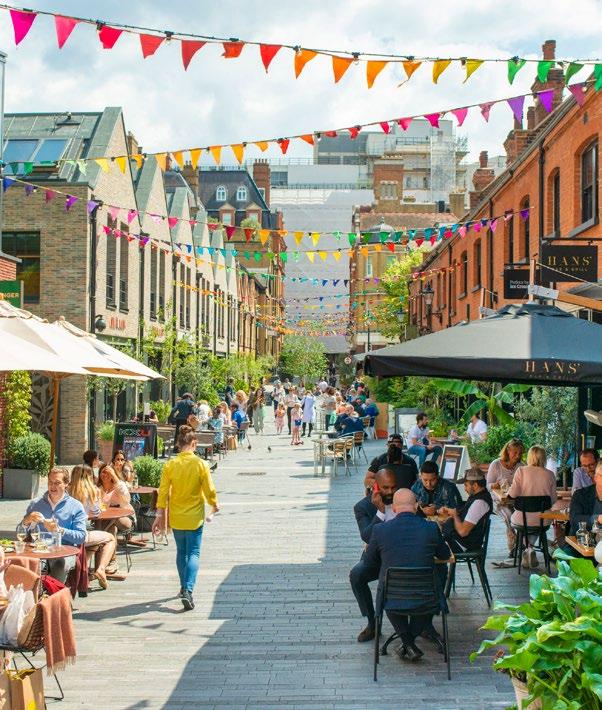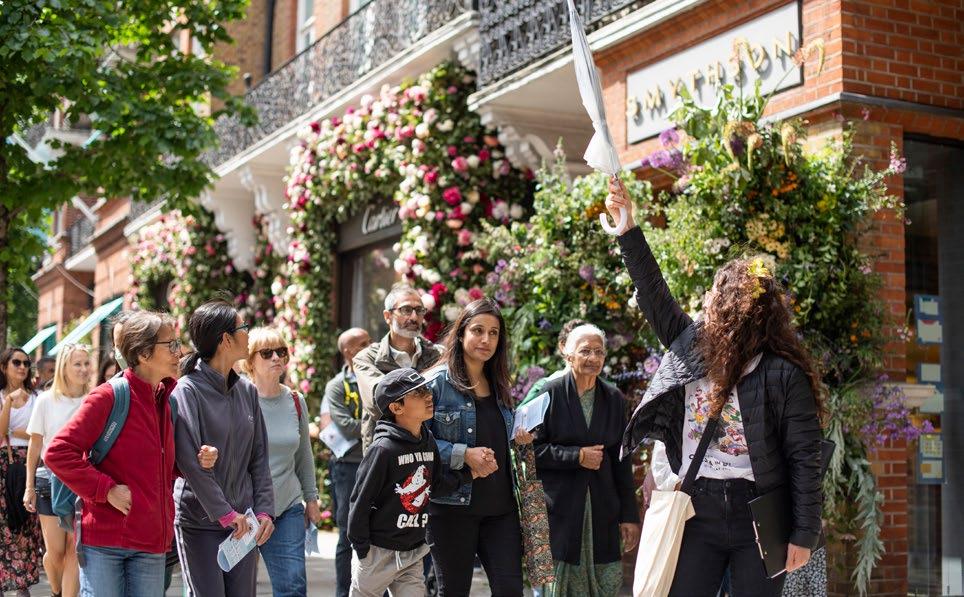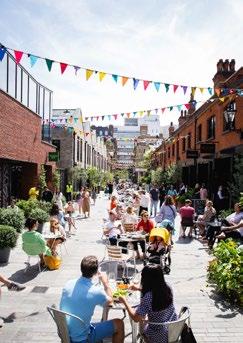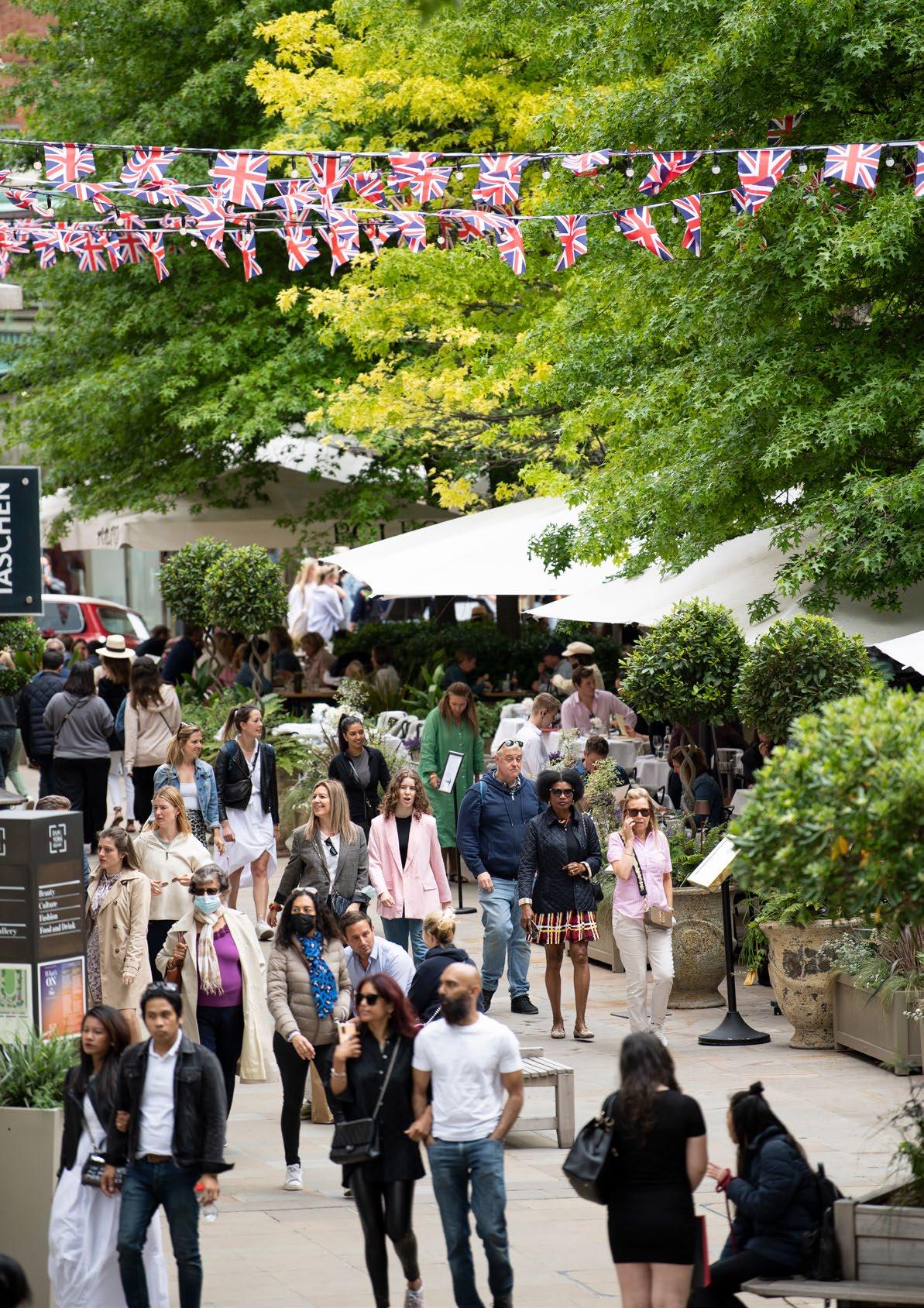
11 minute read
Chief Executive’s Review
An important contributor has been our unwavering focus on a long-term approach to managing and curating the Estate. Our concentrated, continuous property ownership of the area over very many years has allowed us to curate a mix of retail, restaurant, hospitality and cultural uses which contribute greatly to making the area a compelling place to visit. This includes the vital layering of uses over time that combine to create a place with which people develop an emotional connection, such as leisure uses in various forms ranging from a concert hall to a theatre and uses that matter to local residents such as medical facilities, eating and meeting places, schools, parks and beautiful open spaces. This approach applied consistently over a long period has supported a vibrant and thriving residential village in the heart of Central London that has a loyal residential population supplemented by local workers making it less reliant on tourists for footfall. This helps explain why our footfall figures have remained comparatively higher than other parts of central London.
This performance was driven by many factors. Amongst them was our commitment to continue investing throughout the various lockdowns. Our major development projects continued to operate safely, providing financial security for our loyal contractors and advisers as well as ensuring future income streams remained on target. Another factor was the carefully targeted support provided to our occupiers (as well as local charities supporting the community and the NHS) through targeted financial help from the £20m Business Community Fund, set up at the very start of the pandemic. Alongside this we delivered strong marketing support to encourage visitors to return when conditions made this possible, and the provision of over 900 alfresco seats and tables which provided a safe and attractive place to visit and meet family and friends as well as supporting local restaurants.

Cadogan Estate footfall 2022 vs 2019
Footfall is a good indicator of local economic activity. This started to recover following the end of the third national lockdown in April 2021, grew steadily through 2022 and consistently surpassed pre-pandemic footfall levels from April 2022 onwards. Compared to the UK as a whole and other prime central London areas, the footfall growth in Chelsea has been impressive. The high number of visitors was coupled with an increase in average spend per visitor, which led to the majority of our retail and food and drink occupiers seeing turnover and profitability return to or exceed numbers last seen in 2019.
We experienced increasingly buoyant retail leasing activity through 2022, resulting in competing interest for shops and restaurants towards the end of the year. The outcome has been that our vacancy levels remained low, averaging below 3.75% throughout the year and new retail lettings achieved an average rent of 25% above our valuers’ somewhat depressed December 2021 estimated rental values. In the second half of the year, coinciding with an increase in international visitor numbers, there was a marked increase in activity for retail units on Sloane Street. This has been particularly from existing brands increasing the space they occupy, as well as international luxury brands seeking to open a first store in this location. Rents are typically being achieved at, or in excess of, pre-pandemic levels.
In terms of residential, there was strong demand in 2022 for short-let flats and houses coupled to a limited availability of quality units, which translated to healthy rental growth. We started 2021 with a higher level of residential short let vacant properties as a result of the large number of residents vacating during the pandemic and following lockdowns. We devoted significant resources to refreshing these properties so that by the beginning of 2022, vacancy levels had returned to the very low levels which are more typical. This allowed us to take advantage of the strong letting market and boosted rental growth to deliver our highest ever residential income.
Our sustainability strategy, "Chelsea 2030", is an embodiment of our core objectives of creating and maintaining outstanding places and buildings while making a positive contribution towards a sustainable environment and a thriving community over the long term. Climate-related risks and opportunities are considered as part of our strategic approach and financial planning, through the lens of our long-term stewardship and commitment to the community.

In 2022 we focussed on our programme to de-carbonise the portfolio and made good progress, alongside extensive communication with our occupiers and suppliers to assist them with their sustainability objectives. In this report, we will share details of our performance to date against our Chelsea 2030 goals and the status of the various programmes comprising the strategy.
Underpinning our performance is a strong focus on customer service. We aim to:
• Create value through close, direct customer relationships.
• Deliver exemplary customer service to strengthen brand loyalty. We conduct regular surveys of our occupiers, including those that are departing, to understand and learn from their views and experience.
• Forge a strategic collaborative approach to promoting and developing our destinations to drive the success of commercial occupiers.
• Communicate regularly with our occupiers, including regular face-to-face briefings, to communicate our placemaking, development and marketing activities, allowing us to hear feedback and encourage networking.
• Collect trading data to advance our understanding of retail and hospitality performance and inform our estate management strategies.
We have continued to increase investment in destination marketing and local events to promote the area and encourage more people to visit more often and stay for longer. In support of this approach we have initiated and led the creation of two new Business Improvement Districts (BIDs) in the area (The King’s Road Partnership and The Knightsbridge Partnership) both launched after successful ballots, in late 2021. The two BIDs are already demonstrating their value through increased engagement with local property owners, occupiers and wider stakeholders including the local council and residents’ groups, to enhance the environment in their respective areas, increase visitor numbers and improve representation of their members.
We continue to invest heavily in the local area through development and refurbishment activity and through placemaking. The Duke of York Square, which is now well established and was thought to be the first public square created in London in over 100 years, was the result of our acquisition and sensitive redevelopment of the Duke of York’s Barracks. More recently, Pavilion Road was created after we consulted closely with residents about the types of businesses they would like to see. As a result, it is occupied by a variety of artisanal shops able to provide the day-to-day needs of local residents and visitors. This includes a cheesemonger, fishmonger, wine shop, butcher, bakery, shoe repairer, dry cleaners, delicatessen and an eclectic range of restaurants and cafes. Since it has become established and pedestrianised by the local council, it has become a bustling environment in which to meet, be seen and people watch.
We are making an investment of £46m in Sloane Street in partnership with the Royal Borough of Kensington and Chelsea to comprehensively enhance the public realm. This includes replacing all the paving with the highest quality materials, installing carefully designed street lighting and furniture, widening pavements and introducing extensive planting and trees along the entire one kilometre length of the street. Our vision for the project is to reinforce the reputation of Sloane Street as one of the best luxury shopping boulevards in the world while providing beautiful public realm for local residents and all visitors to the area to enjoy.

The launch in 2021 of our sustainability strategy "Chelsea 2030", was accompanied by our Net Zero Pathway (which sets out how we intend to achieve the carbon target). The strategy was developed in collaboration with our local stakeholders and community, peer review and industry analysis. We engaged with a wide range of experts, local organisations and community members through a series of roundtables and a survey which gained over 2,000 responses from members of the local community. Our strategy spans all areas of our business including investments, development and operations.
Our approach is to seek to design, develop and manage buildings to enhance the health of the environment and improve the quality of life for our occupiers and local communities over the long term.
We have committed to designing and building net zero buildings. In every project we aim to reduce lifecycle emissions by prioritising material retention and reuse, adopting smart design, employing the latest construction methods and ensuring net zero is a target in every development from inception. Additionally, with long-term ownership and stewardship in mind, we design and build for resilience and adaptability in a changing climate and society.
To meet our net zero target and stay ahead of impending 2028 Minimum Energy Efficiency Standards (“MEES”) requirements of a minimum EPC rating of B for commercial buildings and minimum EPC rating of C for residential, we have developed a £90m decarbonisation programme which aims to improve the energy efficiency of our assets through insulation, airtightness and carbon reduction, efficient lighting and heating. Strong engagement with our occupiers will not only improve the energy efficiency of accommodation fitout but support behavioural measures to encourage a reduction in consumption within our spaces over time.
Net-zero carbon by 2030
10% carbon saving
Over 2,800 vulnerable people reached, across 39 grassroots organisations £90m decarbonisation programme launched
12.3% increase in Urban Greening Factor


£1.3m annual subsidy of keyworker and community housing, with rental freezes in 2022 to ease cost-of-living pressures
270 people supported with targeted skills development
60 community events
53% increase in operational waste recycled

Overview Of 2022
88.9%
Footfall Consistently Surpassing 2019 Levels
The business has performed strongly in 2022. Total income increased by 10.4% to £186.5m (from £168.9m in 2021), moving decisively ahead of the pre-pandemic high of £171.0m achieved in 2019. In 2022, there was no cost of rental support, rent free periods and write-offs of previously amortised lease incentives as a result of the pandemic (2021 – £3.1m).
Operating profit before capital items (an indicator of underlying operating performance as it excludes profit on the sale of investment properties and revaluation movements), reduced from £100.8m to £98.4m, down 2.4%. The decrease compared to the rise in total income was mainly due to an increase in property expenses as we increased investment in major projects such as the Sloane Street Public Realm.
The capital value of our property portfolio increased by 5.4%, adjusting for purchases, sales and capital expenditure, from £4.8 billion to £5.1 billion. This follows cumulative reductions in 2019 and 2020 before values stabilised in 2021. Values remain 17.2% lower than their 2018 peak of £6.2 billion (lower by 17.5% after adjusting for purchases, sales and capital expenditure).
In 2022, we invested £89.1m in purchases and development which will generate further rental income over time. This was substantially ahead of 2021 (£43.7m) and included three acquisitions of commercial properties with a total cost of £36.2m.
Rental collection has been impressive, returning to prepandemic levels and averaged 99% for commercial rents and 98.5% for residential rents during the year. Almost all the pandemic-related rent arrears have either been collected or disputes have been settled. The net figure for rents written off during the year was nil (2021: £0.6m).
In addition to the usual UK corporate taxes that apply to the group, the trusts that are the ultimate owners of the business are subject to a ten-yearly inheritance tax charge, based on the capital value of the assets and funded by the business. The latest charge was due and paid in 2022. Since 2013, over £200m of dividends paid by the business to its parent company have been used to fund the payment of this tax charge. We have a comprehensive strategy in place to ensure the substantial funding necessary to meet this tax charge is available and will continue to be so at ten-year intervals in future. Key financial highlights of 2022 are set out overleaf.




